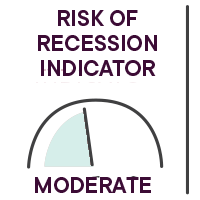Yann Furic
B.B.A., M. Sc., CFA®
Senior Portfolio Manager, Asset Allocation and Alternative Strategies
What moved the markets:
No change to the Bank of Canada’s policy rate, nor to that of the U.S. Federal Reserve.
The U.S. economy is still growing.

|
OVERVIEW OF GLOBAL EQUITY MARKETS |
||||
|
Country |
Index |
Return |
Change |
Year-to-date |
|
Canada |
S&P/TSX |
4.14% |
|
6.62% |
|
United States |
S&P 500 |
2.98% |
|
13.46% |
|
|
Nasdaq |
1.62% |
|
12.19% |
|
International stock markets |
EAFE |
3.05% |
|
8.56% |
|
Emerging markets |
|
2.24% |
|
5.06% |
|
China |
MSCI China |
0.71% |
|
-0.38% |
* All percentages are in Canadian dollars. Source: Morningstar Direct.
Results – Canadian bonds
The FTSE Canada Universe Bond Index, which includes Canadian government and corporate bonds, has posted a negative return of 1.22% year to date (at March 31, 2024).
Source : Morningstar Direct.
Our analysis of events

Positive first quarter 2024 for stock markets
- Year to date, equity markets have posted very attractive returns: 13.3% for the S&P 500, 13.2% for the MSCI Japan, 8.5% for international markets (MSCI EAFE), 6.6% for the S&P/TSX Composite, and 4.7% for emerging markets. (All returns in Canadian dollars.)
- U.S. companies’ first quarter results will begin to be released during the week of April 8.
Policy rates and inflation: where do we stand?
- The U.S. Federal Reserve (Fed) kept its policy rate unchanged at its March 20 meeting. Rate cuts could begin later in the year, towards the end of the first half, and if U.S. economic data remain strong, the situation could prompt the Fed to delay and/or reduce its rate cuts.
Market expectations: The most recent U.S. consumer price index (CPI) data of April 10 came as a nasty surprise, and the market is now expecting only one or two rate cuts in 2024, compared with around six cuts at the start of the year. The U.S. economy remains strong, as do inflationary pressures. - At its meeting on April 10, the Bank of Canada maintained its policy rate at 5%. Inflation is falling, but the BoC wants to see confirmation of this trend before announcing a first cut. It revised its economic growth forecasts for 2024 upwards, from 0.8% to 5%, and expects inflation to fall below 2.5% in the second quarter, and to 2% in 2025.
Market expectations: The market is currently expecting a first cut in Canada in July, and two to three cuts of 0.25% this year, one less than forecast last month. - The European Central Bank is expected to begin rate cuts mid-year, possibly in June, and markets are anticipating a total of three to four cuts of 25% in 2024.
- Canada’s annual inflation rate was 9% for January, down from the previous month and exceeding market expectations. In the United States, the annual inflation rate fell to 3.1% in January, versus market expectations of 2.9%. It was 3.4% in December 2023.
What are the most likely scenarios in 2024?
- The most positive scenario would be a reduction in rates due solely to a decline in inflation, with no pronounced economic slowdown.
- Should the U.S. economy remain strong, the Fed could announce fewer rate cuts than expected by the market. This decision would have a negative impact on the Canadian dollar if the Bank of Canada has to cut its rates to avoid a reduction in household spending during the wave of mortgage renewals in 2025-2026.
- Rates may also have to be cut to revive an economy facing a severe recession.
- Finally, if inflation accelerates while the economic situation deteriorates, a state of stagflation would set in. This scenario is the most negative.
Small and medium-sized businesses want to see rates and inflation come down, as this would make it easier for them to obtain the financing they need to participate in the economic recovery.
Employment situation
In Canada, the unemployment rate was 6.1% in March, up from the previous month (5.8%). This is the highest rate since October 2021, and well above market expectations of 5.9%. The number of unemployed rose by 60,000 to 1.26 million, 65% of whom had been looking for work for more than a month. Hourly wage growth accelerated to 5% on an annual basis, in line with expectations.
The latest U.S. employment numbers far exceeded expectations, with 303,000 jobs added versus forecasts of 214,000. As a result, the unemployment rate fell from 3.9% to 3.8%. Wage growth remained too strong at 4.1%, but was down from the previous month.
Economic indicators
Global Purchasing Managers’ Index ![]()
Indicators in the manufacturing segment held steady, with close to half of the 30 countries posting an index reading above 50 (which signals an expansion). The services segment is also growing, and is improving in Europe, with Germany just passing the 50 mark.
Inflation rate ![]()
Overall, inflation is still too high to consider a significant rate cut. The latest U.S. data are not moving in the right direction.
Benchmark rates in Canada, Europe and the United States ![]()
If it persists, the current level of interest rates will have a major impact on household and business spending when loans are renewed. The latest U.S. inflation numbers are still too high, which will complicate the Fed’s task. This situation will further slow household consumption, as well as investment.
Canada will be particularly hard hit by the upcoming renewal of popular five-year mortgages.

Our strategic monitoring
We are monitoring inflation as well as the leading indicators for manufacturing production, the services sector and employment. A deterioration in these numbers would prompt us to be even more cautious.
A notable improvement in the manufacturing indices and a return to an inflation rate of 2% would be strong signs of an economic recovery, but above all of a possible soft landing for the economy.
Caution and risk management remain our priorities.
Our tactical approach
In March, we increased the weighting of equities in the tactical allocation strategy as the overall economic outlook improved.
In fixed income, we reduced our exposure to Canadian government bonds.
In the United States, we maintained our position in large cap growth stocks, which react positively to stabilizing interest rates, as well as in stocks with a track record of dividend growth which are more defensive.
We increased our position in small cap stocks, which react well to rate cuts, as well as in emerging economies, which respond positively to improved global economic conditions.
We maintained our overweight position in Japan relative to Europe, as the Japanese economic outlook seems brighter to us.
We continue to favour stocks in developed countries and focus on risk management.
To learn how our funds performed:
View the returns
Main risks
- An overly restrictive monetary policy could cause a major recession or other problems, like the U.S. regional bank crisis.
- High interest rates for an extended period would reduce corporate profits and sharply curtail household spending.
- The possibility of an episode of stagflation, i.e. anemic economic growth and high inflation, persists. This situation is negative for stock markets.
- The Israeli-Palestinian conflict could have repercussions throughout the Middle East.
- An escalation of the conflict in Ukraine could spread to other European countries.
- There is also a risk that tensions between China and the United States over Taiwan could worsen.
Senior Manager, Asset Allocation and Alternative Strategies
Data source : Bloomberg
The opinions expressed here and on the next page do not necessarily represent the views of Professionals’ Financial. The information contained herein has been obtained from sources deemed reliable, but we do not guarantee the accuracy of this information, and it may be incomplete. The opinions expressed are based upon our analysis and interpretation of this information and are not to be construed as a recommendation. Please consult your Wealth Management Advisor.




















